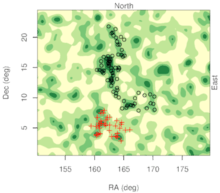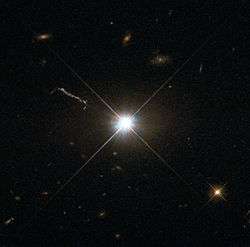Huge-LQG


The Huge Large Quasar Group, (Huge-LQG, also called U1.27) is a possible structure or pseudo-structure of 73 quasars, referred to as a large quasar group, that measures about 4 billion light-years across. At its discovery, it was identified as the largest and the most massive known structure in the observable universe,[1][2][3] though it has been superseded by the Hercules-Corona Borealis Great Wall at 10 billion light-years.[4] There are also issues about its structure (see Dispute section below).
Discovery
Roger G. Clowes, together with colleagues from the University of Central Lancashire in Preston, United Kingdom, has reported on January 11, 2013 a grouping of quasars within the vicinity of the constellation Leo. They used data from the DR7QSO catalogue of the comprehensive Sloan Digital Sky Survey, a major multi-imaging and spectroscopic redshift survey of the sky. They reported that the grouping was, as they announced, the largest known structure in the observable universe. The structure was initially discovered in November 2012 and took two months of verification before its announcement. News about the structure's announcement spread worldwide, and has received great attention on the scientific community.
Characteristics
The Huge-LQG was estimated to be about 1.24 Gpc in length, by 640 Mpc and 370 Mpc on the other dimensions, and contains 73 quasars, respectively.[5] Quasars are very luminous active galactic nuclei, thought to be supermassive black holes feeding on matter. Since they are only found in dense regions of the universe, quasars can be used to find overdensities of matter within the universe. It has the approximate binding mass of 6.1×1018 (6.1 trillion (long scale) or 6.1 quintillion (short scale)) M☉. The Huge-LQG was initially named U1.27 due to its average redshift of 1.27, placing its distance at about 9 billion light-years from Earth.[6]
The Huge-LQG is 615Mpc from the Clowes–Campusano LQG (U1.28), a group of 34 quasars also discovered by Clowes in 1991.
Cosmological principle
In Clowes' initial announcement of the structure, he has reported that the structure has contradicted the cosmological principle. The cosmological principle implies that at sufficiently large scales, the universe is approximately homogeneous, meaning that the statistical fluctuations in quantities such as the matter density between different regions of the universe are small. However, different definitions exist for the homogeneity scale above which these fluctuations may be considered sufficiently small, and the appropriate definition depends on the context in which it is used. Jaswant Yadav et al. have suggested a definition of the homogeneity scale based on the fractal dimension of the universe; they conclude that, according to this definition, an upper limit for the homogeneity scale in the universe is 260/h Mpc.[7] Some studies that have attempted to measure the homogeneity scale according to this definition have found values in the range 70–130/h Mpc.[8][9][10]
The Sloan Great Wall, discovered in 2003, has a length of 423Mpc,[11] which is marginally larger than the homogeneity scale as defined above.
The Huge-LQG is three times longer than, and twice as wide as the Yadav et al. upper limit to the homogeneity scale, and has therefore been claimed to challenge our understanding of the universe on large scales.[3]
However, due to the existence of long-range correlations, it is known that structures can be found in the distribution of galaxies in the universe that extend over scales larger than the homogeneity scale.[12]
Dispute
Seshadri Nadathur at the University of Bielefeld has conducted an even more comprehensive study of the Huge-LQG. After a more detailed study, he announced that contrary to the claim by Clowes about a large clustering, has showed that in his new map, that there is no clear clustering of quasars within the vicinity of the Huge-LQG. The map was actually a similar map created by Clowes above, but includes all the quasars in that region. After performing a number of statistical studies on the quasar data, and finding extreme changes in the Huge-LQG membership and shape with small changes in the cluster finding parameters, he determined the probability that apparent clusters the size of the Huge-LQG would appear in a random assortment of quasars. He set up 10,000 regions identical in size to that studied by Clowes, and filled them with randomly distributed quasars with the same position statistics as did the actual quasars in the sky.[10] The data is supporting the study of the homogeneity scale by Yadav et al.,[7] and that there is therefore no challenge to the cosmological principle. The study also implies that the statistical algorithm used by Clowes to identify the Huge-LQG, when used to correlate other quasars in the sky, produces more than a thousand clusterings identical to the Huge-LQG. While quasars can represent dense regions of the universe, one must note that all of the quasars in the sky are evenly distributed, that is, one quasar per few million light years, making their significance as a structure very unlikely. The identification of the Huge-LQG, together with the clusterings identified by Nadathur, is therefore referred to be false positive identifications, or errors in identifying structures, finally arriving to the conclusion that the Huge-LQG is not a real structure at all.
Several questions arose from the structure's discovery. But it is not told how Clowes detected a clustering of quasars in the region, nor how he found any correlation of quasars in the region. It is specified, that, not only the structure, but also other LQGs are not real structures at all.
Nevertheless, Clowes et al. found independent support for the reality of the structure from its coincidence with Mg II absorbers (once-ionised magnesium gas, commonly used to probe distant galaxies). The Mg II gas suggests that the Huge-LQG is associated with an enhancement of the mass, rather than being a false positive. This point is not discussed by the critical paper.[10]
Further support for the reality of the Huge-LQG comes from the work of Hutsemékers et al.[13] in September 2014. They measured the polarization of quasars in the Huge-LQG and found "a remarkable correlation" of the polarization vectors on scales larger than 500 Mpc.
See also
- Large-scale structure of the cosmos
- Galaxy filament
- Sloan Great Wall
- Pisces–Cetus Supercluster Complex
- CfA2 Great Wall
- Hercules–Corona Borealis Great Wall
References
- ↑ Aron, Jacob. "Largest structure challenges Einstein's smooth cosmos". New Scientist. Retrieved 14 January 2013.
- ↑ "Astronomers discover the largest structure in the universe". Royal astronomical society. Retrieved 2013-01-13.
- 1 2 Clowes, Roger G.; Harris, Kathryn A.; Raghunathan, Srinivasan; Campusano, Luis E.; Söchting, Ilona K.; Graham, Matthew J. (2013-01-11). "A structure in the early Universe at z ∼ 1.3 that exceeds the homogeneity scale of the R-W concordance cosmology". Monthly Notices of the Royal Astronomical Society. 1211 (4): 6256. arXiv:1211.6256
 . Bibcode:2013MNRAS.429.2910C. doi:10.1093/mnras/sts497. Retrieved 14 January 2013.
. Bibcode:2013MNRAS.429.2910C. doi:10.1093/mnras/sts497. Retrieved 14 January 2013. - ↑ SciShow Space (21 July 2016). "The Impossibly Huge Quasar Group".
- ↑ "The Largest Structure in Universe Discovered – Quasar Group 4 Billion Light-Years Wide Challenges Current Cosmology". Retrieved 14 January 2013.
- ↑ Prostak, Sergio (11 January 2013). "Universe's Largest Structure Discovered". scinews.com. Retrieved 15 January 2013.
- 1 2 Yadav, Jaswant; Bagla, J. S.; Khandai, Nishikanta (25 February 2010). "Fractal dimension as a measure of the scale of homogeneity". Monthly Notices of the Royal Astronomical Society. 405 (3): 2009–2015. arXiv:1001.0617
 . Bibcode:2010MNRAS.405.2009Y. doi:10.1111/j.1365-2966.2010.16612.x. Retrieved 15 January 2013.
. Bibcode:2010MNRAS.405.2009Y. doi:10.1111/j.1365-2966.2010.16612.x. Retrieved 15 January 2013. - ↑ Hogg, D.W.; et al. (2005). "Cosmic Homogeneity Demonstrated with Luminous Red Galaxies". The Astrophysical Journal. 624: 54–58. arXiv:astro-ph/0411197
 . Bibcode:2005ApJ...624...54H. doi:10.1086/429084.
. Bibcode:2005ApJ...624...54H. doi:10.1086/429084. - ↑ Scrimgeour, Morag I.; et al. (2012). "The WiggleZ Dark Energy Survey: the transition to large-scale cosmic homogeneity". Monthly Notices of the Royal Astronomical Society. 425 (1): 116–134. arXiv:1205.6812
 . Bibcode:2012MNRAS.425..116S. doi:10.1111/j.1365-2966.2012.21402.x.
. Bibcode:2012MNRAS.425..116S. doi:10.1111/j.1365-2966.2012.21402.x. - 1 2 3 Nadathur, Seshadri, (July 2013) "Seeing patterns in noise: gigaparsec-scale 'structures' that do not violate homogeneity". Monthly Notices of the Royal Astronomical Society in press. arXiv:1306.1700. Bibcode: 2013MNRAS.tmp.1690N doi:10.1093/mnras/stt1028
- ↑ Gott, J. Richard, III; et al. (May 2005). "A Map of the Universe". The Astrophysical Journal. 624 (2): 463–484. arXiv:astro-ph/0310571
 . Bibcode:2005ApJ...624..463G. doi:10.1086/428890
. Bibcode:2005ApJ...624..463G. doi:10.1086/428890 - ↑ Gaite, Jose; Dominguez, Alvaro; Perez-Mercader, Juan (1999). "The fractal distribution of galaxies and the transition to homogeneity". The Astrophysical Journal. 522: 5–8. arXiv:astro-ph/9812132
 . Bibcode:1999ApJ...522L...5G. doi:10.1086/312204.
. Bibcode:1999ApJ...522L...5G. doi:10.1086/312204. - ↑ Hutsemekers, D.; Braibant, L.; Pelgrims, V.; Sluse, D. "Alignment of quasar polarizations with large-scale structures". Astronomy & Astrophysics. arXiv:1409.6098
 . Bibcode:2014A&A...572A..18H. doi:10.1051/0004-6361/201424631.
. Bibcode:2014A&A...572A..18H. doi:10.1051/0004-6361/201424631.
Further reading
- Clowes, Roger G.; Harris, Kathryn A.; Raghunathan, Srinivasan; Campusano, Luis E.; Soechting, Ilona K.; Graham, Matthew J. (2013). "A structure in the early universe at z ~ 1.3 that exceeds the homogeneity scale of the R-W concordance cosmology". Monthly Notices of the Royal Astronomical Society. 429: 2910–2916. arXiv:1211.6256
 . Bibcode:2013MNRAS.429.2910C. doi:10.1093/mnras/sts497.
. Bibcode:2013MNRAS.429.2910C. doi:10.1093/mnras/sts497.
External links
- http://www.star.uclan.ac.uk/~rgc/
- Sixty Symbols: Biggest Thing in the Universe (Video)